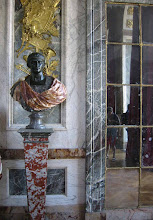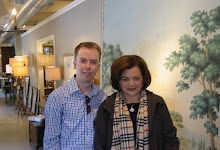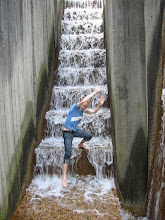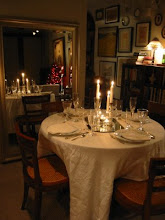One thing not to miss at the Louvre, out of many items not to miss, are the state apartments of Napoleon III. I've visited a lot of opulent places in my travels but never seen something on this scale and so completely over the top.
Built between 1854 and 1861 by the architect Hector Lefuel, the set of rooms was basically built for partying and entertaining. How could you fail to impress guests of the State when this is the setting?
Long hallways lead you past anterooms designed for large scale gatherings through a stately enfilade until you reach the Grand Salon.
Every square inch is ornate; designed to within an inch of its life. And it's totally magnificent.
The ceiling of the Grand Salon is a painting by Charles-Raphael Marechal depicting the building of the wing itself: The Reuniting of the Louvre and the Tuileries by Napoleon III.
I love the filtered light through the many windows. The low light from the now electrified chandliers almost appears as candlelight at this time of day.
The view out the windows isn't so bad either.
I loved this little side table nestled between pilasters; a perfect spot to place your drink at a party or more likely for a candelabra.
Small rooms dot the enfilade, such as this card playing chamber.
The small dining room features magnificent wall murals.
The apartments have been faithfully restored and the upholstery and gilding looks brand new; probably the same as in the 1860s (minus the smog).
The grand dining room features an immense table and a ceiling painted by Eugene Appert depicting exotic birds in flight.
The paneled opening at the end of the dining room sets the symmetry of the space as the entry is off center.
The large sideboard of course would have been loaded with cut glass, silver, and exotic fruits to impress guests.
This service hall of sorts runs the length of the apartments and dining room. Even the underside of the circular stair is decorated; no detail overlooked.
At the end of the apartments is a gilded bed and balustrade from the throne room of Napoleon I. Not your standard 1 bedroom apartment.
Before visiting the Louvre, make sure the apartments of Napoleon III are open on the day of your visit as they close periodically.
Subscribe to:
Post Comments (Atom)


























































































































11 comments:
Stefan, what words are there! Magnificent, opulent, artistic craftsmanship never to be found again!
Thank you so much for sharing this treasure
xoxo
Karena
2013 Artists Series!!
In a way it is ironic that Emperor Louis-Napoléon III had the most expensive, most opulent, most decadent state apartments in the universe. Since he was the nephew of Emperor Napoleon I (by his brother Louis Bonaparte and Hortense de Beauharnais), you would have thought he might have understood about the French Revolution and the need for equality and non-decadence.
Still.. I suppose the dining room had to be splendid. For the glory of France, I mean.
I would definitely agree - the apartments were my favourite part of the Louvre, right up there with Versailles ( and I know how much you love Versailles!).
It is interesting how much Napoleon became another 'king' really, despite the revolution and all that had followed.
Wonderful to see all this! Now you've sent me on a quest to discover more about Marechal and Appert.
Wow! I love seeing this sort of opulence - it is unbelievable how "over the top" things can be if you have enough money and a big ego to match! Thanks for sharing. I will put this on my to-do list!
Always wonderful to see this part of the museum. I was able to visit it in the 90s, but I don't think all of the rooms were on view then. It's quite remarkable, and we're so fortunate to have this perfect evocation of what was lost in the destruction of the Tuileries, that ghost palace that lingers between the pavilions at the far west end of the Louvre complex.
If you look closely enough at Napoleon's bed, you can see that what most certainly would have been "N"s at the center of both foot and headboard have been replaced with the Bourbon fleur de lis; Napoleon may have "slept here", but so did his "successor", Louis XVIII! : )
As I am sure we all know – and as you implied in your fascinating previous posting – although these magnificent rooms in the Louvre complex are shamelessly marketed as the “Napoleon II apartments” they were never of course occupied by the imperial family, but were rather the official residence of the Ministre d’Etat - the chief minister in the government. Indeed, one of the (original) clocks has this title on the dial.
The apartments of the emperor in the Tuileries chateau across the courtyard were far bigger and more opulent, and more historic - and no longer exist, though all the superb furniture, fittings, and moveable works of art do.
Napoleon III was indeed emperor, and his reign confirmed by a strong endorsement in two plebiscites – and one of the reasons for his popularity was the restoration of a modern, efficient, confident and, above all, opulent ‘empire’, with memories of the first Napoleon’s military triumphs. This is in contrast to the dowdy bourgeois King Louis Philippe and the incompetent and eccentric Bourbons.
I've never seen these rooms... they are wonderfully madly overdone, aren't they? So much like the time he lived in with bare shoulders over acres of skirt and opulence as far as the eye could see. Too bad the War put an end to it all. At least we can see what it had been like... thanks for the brilliant tour!
I will never forget visiting here. I was flabbergasted to say the least. I simply cannot grasp such grandeur that long ago.
Hi Stefan,
Do the circular 3 or 4 part seats with the palms in the centre have a particular name?
Napolen III never lived in these apartments he lived in the Tuileries Palace nearby. He had these built for the First Minister to use for official entertainment. The First Minister was the equivalent of the Prime Minister. After the fall of the Second Empire in 1870 they were taken over by the Ministry of Finance and were used for official entertainment until relatively recently. The Louvre Museum wanted to add them to their exhibits and the Ministry of Finance was asked to leave.
The French palaces were conglomerations of residential apartments and ministries. They were built to look uniform to be impressive.
If you add in the square footage of the White House, the vast underground sections of it, the full square block of the executive office building adjacent to it and then also add in the multi-mansions across the street used for official entertainment of visiting dignitaries you would find that the "modest" size of the executive complex in Washington, D.C. is very deceptive.
Post a Comment